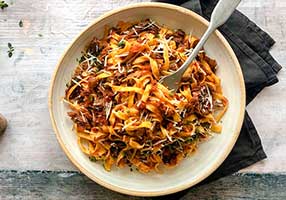The attachment comes with one die included, but
other different shaped dies are available to buy separately, each one used to make a different pasta shape. Included in your pack is the Maccheroni Rigati die, which can be used to make macaroni.
All of these high quality bronze dies give the pasta a rough, more porous surface favoured by artisanal producers because it allows sauces to cling to the pasta for a more authentic flavour.
Choosing the right pasta shape for your dish is a serious business in Italy. Generally speaking, tubular shapes are paired with thicker sauces because the sauce gets trapped within them and you get lots of flavour in every mouthful, whereas long strands are good for absorbing juices from more delicate sauces without going soft. Get creative with the 12 other shapers available:
Bigoli- long, thick tubes with a heavily textured surface, perfect for serving with thick sauces like a meat ragu.
Bucatini- a thicker type of spaghetti with a narrow hollow centre, traditionally served with a classic Amatriciana sauce.
Casarecce- originally from Sicily, these short twists of pasta with curled edges and a groove down the middle are traditionally paired with sauces made using Mediterranean ingredients like tomato, basil and eggplant.
Conchigliette- small shell shapes with a ridged exterior that are used to add extra heartiness to broths and soups.
Fusilli- short, spiral shaped twists that are often served with heavier, meat or cream-based sauces that get trapped in the grooves. Also can be used cold in pasta salads.
Linguine- long flat strands of pasta that are super versatile and complement a variety of sauces. Can also be used in stir-fries.
Maccheroni Lisci- short tubes that work really well in baked pasta dishes.
Orecchiette- translated literally as ‘little ears’, this pasta's cup-like shape makes it great for holding sauces.
Pappardelle- broad, flat ribbons of pasta, often served with hearty meat or game based sauces.
Silatelli- short strips of tagliatelle which are pinched in the middle. Traditionally cooked with courgettes, or seafood like mussels or clams.
Spaccatelli- similar to bucatini, these long rolled up scrolls work especially well with chunkier sauces that can wrap into the pasta’s folds.
Spaghetti Quadri- known the world over simply as spaghetti, these long round strands of smooth pasta are best paired with light sauces like a carbonara, or with seafood.










